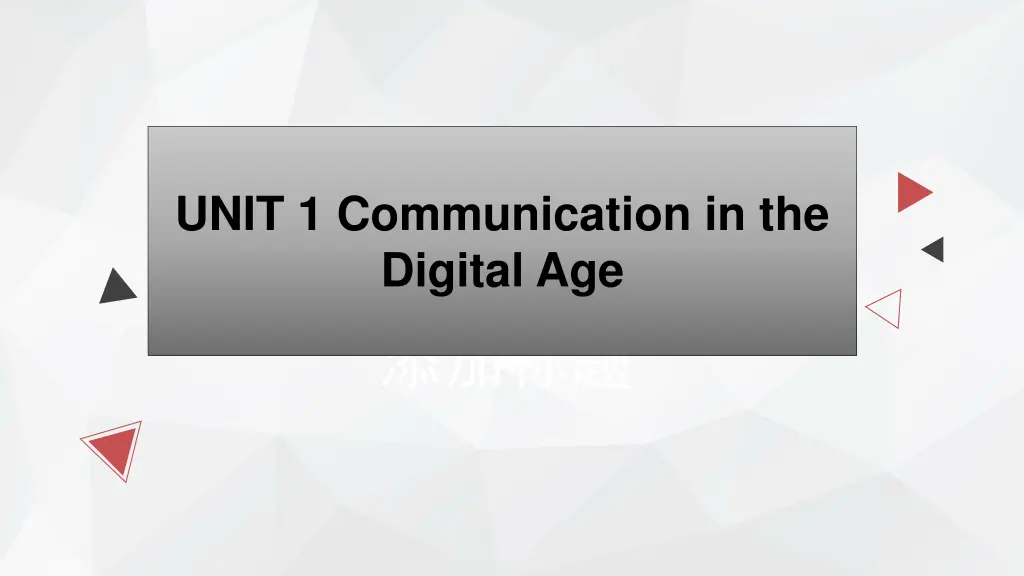
Teaching Strategies for Communication in the Digital Age
Explore teaching methods, materials, and objectives for effective communication in the digital age. Enhance linguistic competence, critical thinking, and humanistic quality through a blend of online and offline resources. Empower students with analytical and collaborative skills to navigate digital communication challenges.
Download Presentation

Please find below an Image/Link to download the presentation.
The content on the website is provided AS IS for your information and personal use only. It may not be sold, licensed, or shared on other websites without obtaining consent from the author. If you encounter any issues during the download, it is possible that the publisher has removed the file from their server.
You are allowed to download the files provided on this website for personal or commercial use, subject to the condition that they are used lawfully. All files are the property of their respective owners.
The content on the website is provided AS IS for your information and personal use only. It may not be sold, licensed, or shared on other websites without obtaining consent from the author.
E N D
Presentation Transcript
UNIT 1 Communication in the Digital Age
Introduction iEnglish: An Integrated Course (2) Unit 1 Communication in the Digital Age
1. Introduction: the unit 01 Teaching analysis 02 Teaching procedures content 03 Teaching reflection
Teaching analysis 01 1.1 Target students sophomore, Level A, iGeneration English proficiency Motivation Analytical thinking
Teaching analysis 01 1.2 Teaching materials On-line resources forwarded to students Textbook (selected)& materials designed for specific teaching purposes Blended Students on-line tasks, records, study journals (U-campus) PPT, student worksheet On-line Off-line
Teaching analysis 1.3 Teaching objectives 01 Linguistic competence Topic-related words & expressions; Writing skills Instrumental objectives Ability of discourse analysis Identify the author s tone of writing; Graphically illustrate relations between key words
Teaching analysis 01 Analytical/critical thinking Pros & cons of digital and face-to-face communication Humanistic objectives Humanistic quality iGeneration with positive values of network culture Autonomous/explorative/collaborative learning Individual work, group work, pair work
Teaching procedures 02 Keyword: output-driven ( POA , Wen Qiufang) Assessing Motivating Enabling Task 1: problem identification Task 2: problem solving Task 3: consolidation & reflective learning (new problem)
Teaching Process Teaching procedures Assign tasks Teacher as the scaffolder A/M Motivating 6 5 1 Output -driven Summarize 2 4 Enabling Assessing 3 3-step teaching: M-E-A E
Self- assessment T-S Peer assessment collaborative assessment
Teaching reflection 03 Output- driven teaching Blended teaching Learning- centeredness T-S collaborative assessment
2. Introduction: the demo class 2.1 Teaching content The development of emojis The role of emojis Relations among text, emoticon and emojis Before class In class: text analysis After class 01 iExplore1: emojis Unit 1 Digital 02 iExplore2: face-to-face communication 03 iProduce: unit project
How do they interact? task3 task2 task1 Produce Analyze Search Advanced, Challenging & Innovative Learning
2.3 Teaching procedures 2.2 Teaching objectives Outcome 1: Analyze the relations Task 1: iSearch Task 2: iAnalyze Task 2: iDesign Task 3: iProduce Outcome 2: Explain the relations
DEMO CLASS TIME! DEMO CLASS TIME!
IExplore Why emojis are a no- brainer for digital communication?
Digital communication text emoticon emoji
Whats the relation among the text, emoticon and emoji in digital communication?
A linear relationship? Digital text emoticon emoji communicatio n
text Digital communication emoticon emoji
I Search groups groups members members tasks tasks Functions Functions +features +features 1 11, 12,13 text 2 21,22,23 emoticon 3 31,32,33 emoji
Account for only 30% of information Lose their meaning or be misinterpreted Take the empathy out of message text emoticon Put empathy back Put empathy back Accessible Easy to use No-brainer Help people online say what they mean emoji
I Re-search In Britain, almost 100% of smartphone users text ___emojis.(para3) Where text took the ___out of messages, emoticons and emojis put it ____ in.(para8) The use of emojis quickly _____ that of emoticons for two key reasons.(para9) It needs this kind of system to ___and ___ the messages coming from text.(para15)
I Analyze groups groups 1 2 3 members members 11, 21,31 12,22,32 13,23,33 tasks tasks The relations among the four
1 4 7 2 5 8 3 6 9
I Design Design a chart to show the relations among digital communication text emoticon and emoji. Digital text communication emoticon emoji
I Produce digital communication text emoji meme emoticon
I Produce Further digital communication text emoji meme emoticon
